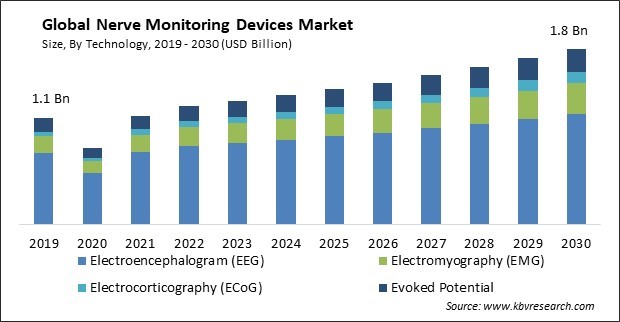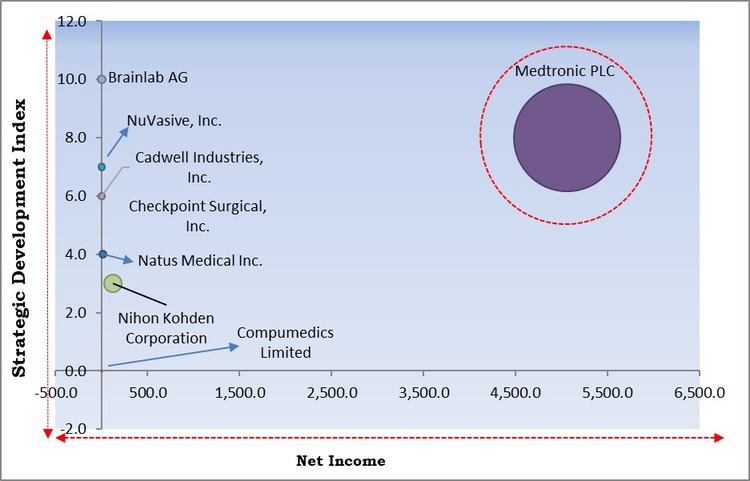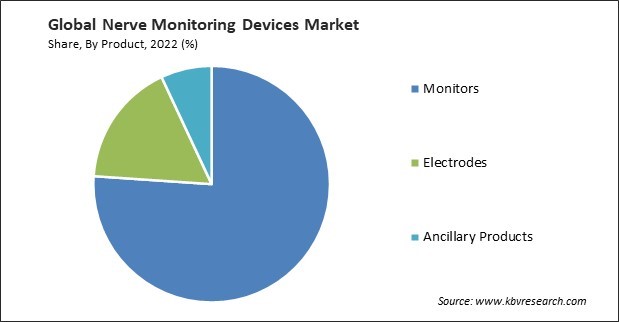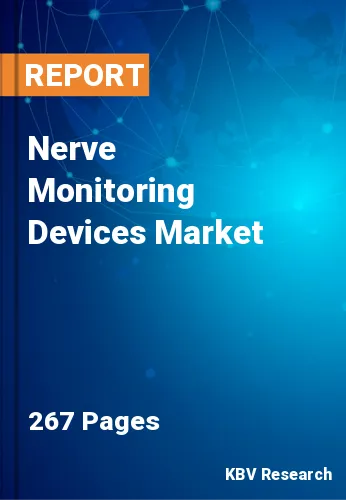The Global Nerve Monitoring Devices Market size is expected to reach $1.8 billion by 2030, rising at a market growth of 5.2% CAGR during the forecast period.
Somatosensory Evoked Potentials (SSEPs) are a type of neurophysiological test used in clinical medicine to assess the function of the somatosensory pathways in the nervous system. SSEP testing involves measuring the electrical signals generated in response to sensory stimuli applied to specific peripheral nerves. Therefore, Somatosensory Evoked Potentials (SSEPs) segment generated $63.4 million revenue in the market in 2022. These tests provide valuable information about the integrity and function of sensory pathways, helping diagnose and monitor various neurological conditions. SSEP testing involves two primary steps: stimulation and recording. During stimulation, a controlled electrical stimulus or mechanical vibration is applied to a specific peripheral nerve, typically at various points along the limb. The stimulus travels along the sensory pathway towards the central nervous system.

The major strategies followed by the market participants are Mergers & Acquisition as the key developmental strategy to keep pace with the changing demands of end users. For instance, In September, 2022, Brainlab AG took over Dr. Langer Medical GmbH. Through this acquisition, Brainlab integrated Dr. Langer Medical GmbH’s neuromonitoring services and solutions to amplify neuronavigation through the integration of critical data components. Additionally, In October, 2020, Medtronic PLC announced the acquisition of Avenu Medical, Inc. Through this acquisition, Medtronic has supported the vascular access care continuum and provided endovascular therapies to patients suffering from ESRD across the world.
Based on the Analysis presented in the KBV Cardinal matrix; Medtronic PLC is the forerunner in the Market. Companies such as Nihon Kohden Corporation, Brainlab AG, Natus Medical Inc. are some of the key innovators in the Market. In January, 2023, Natus Medical Incorporated completed the acquisition of Micromed Holding SAS, a global leader in neurophysiology. Through this acquisition, neuroscience users are able to access comprehensive products, global service and support through the combined resources.

Many surgical procedures carry inherent risks, including the potential for nerve damage. Nerve monitoring devices help surgeons and healthcare professionals identify and monitor nerve function in real-time, reducing the risk of unintentional nerve injury during surgery. This risk mitigation is especially crucial in complex and delicate nervous system surgeries. Advances in surgical techniques have expanded the scope of surgical procedures, including minimally intrusive and robotic-assisted surgeries. These advanced procedures often require precise nerve monitoring to ensure optimal outcomes and safety. The increasing number of ENT surgeries contributes to the demand for nerve monitoring devices. As surgical techniques evolve and the demand for surgical procedures grows, the market is expected to develop continually, driven by the imperative to enhance patient safety and surgical outcomes.
Technological advancements have significantly driven growth in the market. These advancements have led to the development of more sophisticated, accurate, and user-friendly nerve monitoring devices, making them increasingly valuable in various surgical and medical contexts. Modern nerve monitoring devices offer surgeons and medical teams real-time monitoring and immediate feedback. This real-time information allows for timely adjustments during surgery, reducing the risk of nerve damage. Nerve monitoring devices are increasingly integrated with surgical navigation systems, allowing for precise mapping, and tracking of nerve pathways. Surgeons can use these systems to plan and execute procedures more accurately. Advanced software capabilities have improved data analysis and visualization. These technological advancements have extended the range of surgeries where nerve monitoring is feasible and increased the overall adoption of nerve monitoring devices in healthcare settings.
Nerve monitoring devices can be capital-intensive, requiring a substantial upfront investment by healthcare facilities. This expenditure may strain the financial resources of hospitals, particularly smaller or non-profit institutions with limited budgets. Beyond the initial purchase cost, ongoing expenses are associated with maintaining and operating nerve monitoring devices. This includes the cost of regular maintenance, calibration, and the purchase of disposable electrodes and accessories. High costs can contribute to global disparities in access to advanced healthcare technologies. Some regions may have limited access to nerve monitoring devices due to cost-related factors. Due to such factors, market growth will be hampered.
On the basis of product, the market is segmented into monitors, electrodes, and ancillary products. In 2022, the monitors segment dominated the market with the maximum revenue share. Due to the increasing number of surgical processes, neurological disorders, and technological advancements. The main monitoring unit or device receives signals from the electrodes and processes the data. It typically displays real-time information about nerve function. This equipment may have built-in software for data analysis and visualization. It allows healthcare professionals to track nerve activity during surgery or medical procedures. In the coming years, disposable sponge disks, disposable filters, alcohol swabs, abrasive gel, and electrode lotions are expected to increase in demand. Increased utilization and repeat purchases will likely drive segment growth.

Based on technology, the market is fragmented into electroencephalogram (EEG), evoked potential, electromyography (EMG), and electrocorticography (ECoG). The electromyography (EMG) segment recorded a remarkable revenue share in the nerve monitoring device market in 2022. EMG is a valuable tool for healthcare professionals to diagnose and monitor conditions affecting the neuromuscular system. The results of EMG testing help guide treatment decisions, rehabilitation programs, and the management of neuromuscular disorders. The procedure is generally well-tolerated, and discomfort or mild pain during needle electrode insertion is usually temporary. EMG testing is typically performed by neurologists, clinical neurophysiologists, or specially trained technologists.
| Report Attribute | Details |
|---|---|
| Market size value in 2022 | USD 1.2 Billion |
| Market size forecast in 2030 | USD 1.8 Billion |
| Base Year | 2022 |
| Historical Period | 2019 to 2021 |
| Forecast Period | 2023 to 2030 |
| Revenue Growth Rate | CAGR of 5.2% from 2023 to 2030 |
| Number of Pages | 267 |
| Number of Table | 373 |
| Report coverage | Market Trends, Revenue Estimation and Forecast, Segmentation Analysis, Regional and Country Breakdown, Competitive Landscape, Companies Strategic Developments, Company Profiling |
| Segments covered | Technology, Product, Region |
| Country scope | US, Canada, Mexico, Germany, UK, France, Russia, Spain, Italy, China, Japan, India, South Korea, Singapore, Malaysia, Brazil, Argentina, UAE, Saudi Arabia, South Africa, Nigeria |
| Growth Drivers |
|
| Restraints |
|
Region-wise, the market is analyzed across North America, Europe, Asia Pacific, and LAMEA. In 2022, the North America region witnessed the largest revenue share in the market. Due to its sophisticated healthcare system and the rising usage of nerve monitoring in trauma cases. Moreover, rising disposable income and favorable reimbursement policies facilitate preventive & early diagnosis, thereby increasing the demand for nerve monitoring devices. Cardiovascular disease is the foremost cause of death in the US. As a result of the high prevalence of cardiac disease, numerous cardiological surgical procedures are conducted, which can potentially lead to nerve damage.
Free Valuable Insights: Global Nerve Monitoring Devices Market size to reach USD 1.8 Billion by 2030
The market research report covers the analysis of key stake holders of the market. Key companies profiled in the report include Medtronic PLC, NuVasive, Inc., Natus Medical Inc., Neuspera Medical, Inc., Brainlab AG, Checkpoint Surgical, Inc., Cadwell Industries, Inc., Compumedics Limited, Magstim EGI (Magstim, Inc.), and Nihon Kohden Corporation.
By Technology
By Product
By Geography
This Market size is expected to reach $1.8 billion by 2030.
Rising demand for product owing to increasing surgical procedures are driving the Market in coming years, however, Requirement of substantial upfront investments restraints the growth of the Market.
Medtronic PLC, NuVasive, Inc., Natus Medical Inc., Neuspera Medical, Inc., Brainlab AG, Checkpoint Surgical, Inc., Cadwell Industries, Inc., Compumedics Limited, Magstim EGI (Magstim, Inc.), and Nihon Kohden Corporation.
In the year 2022, the market attained a volume of 2,799.3 Tonnes, experiencing a growth of 7.2% (2019-2022).
The Electroencephalogram (EEG) segment is leading the Market, by Technology in 2022 thereby, achieving a market value of $1.2 billion by 2030.
The North America region dominated the Market, by Region in 2022, and would continue to be a dominant market till 2030; thereby, achieving a market value of $747 Million by 2030.
Our team of dedicated experts can provide you with attractive expansion opportunities for your business.

